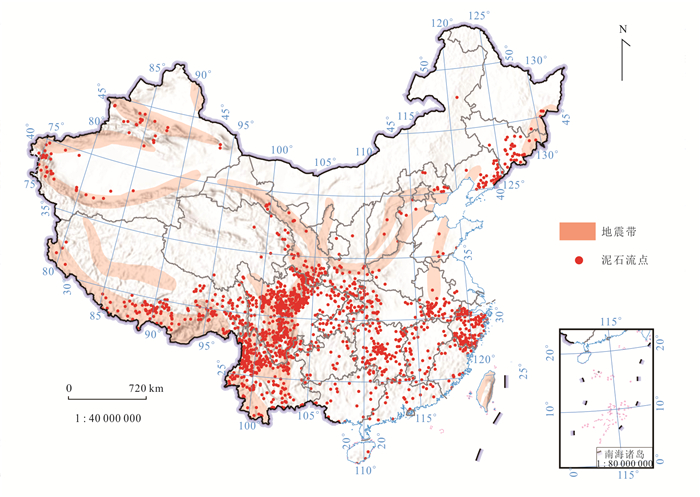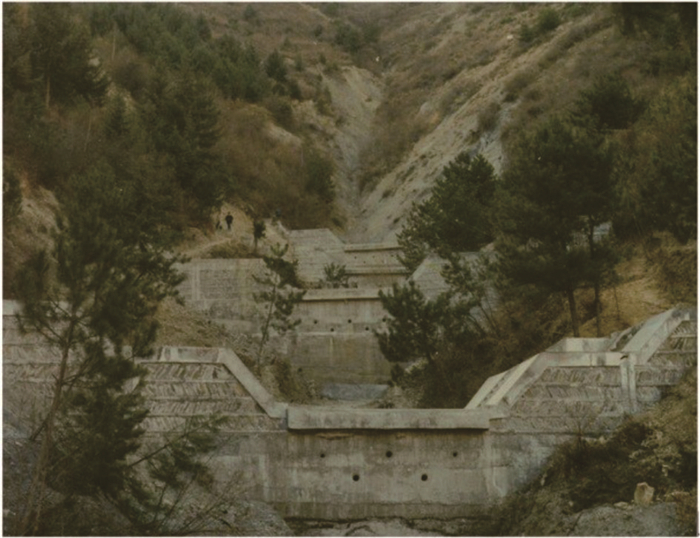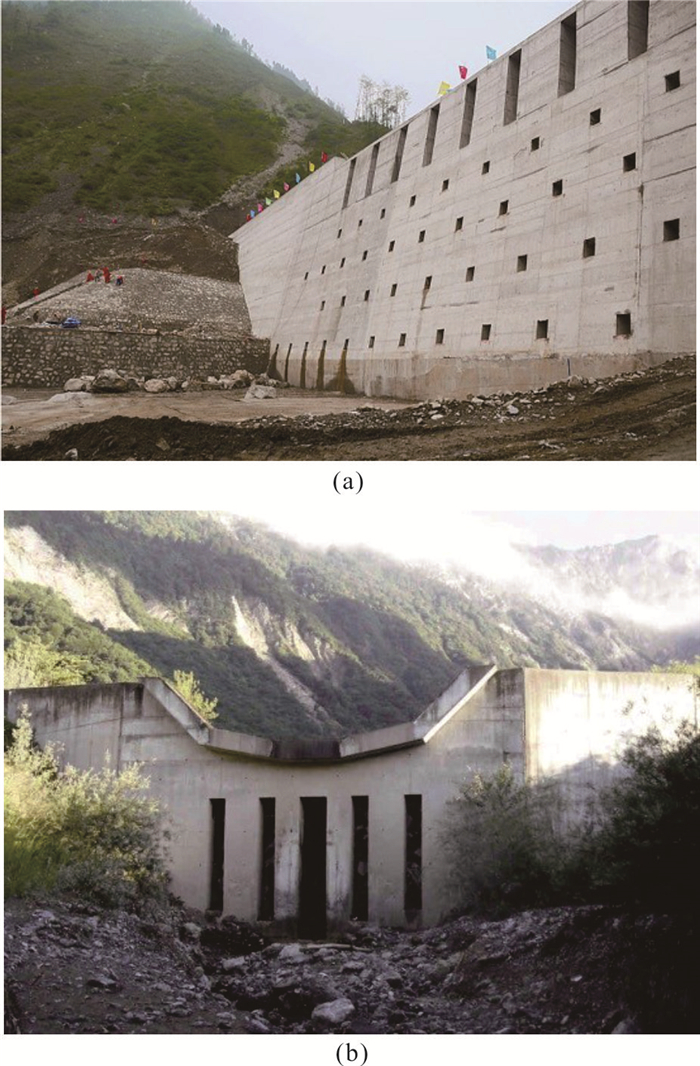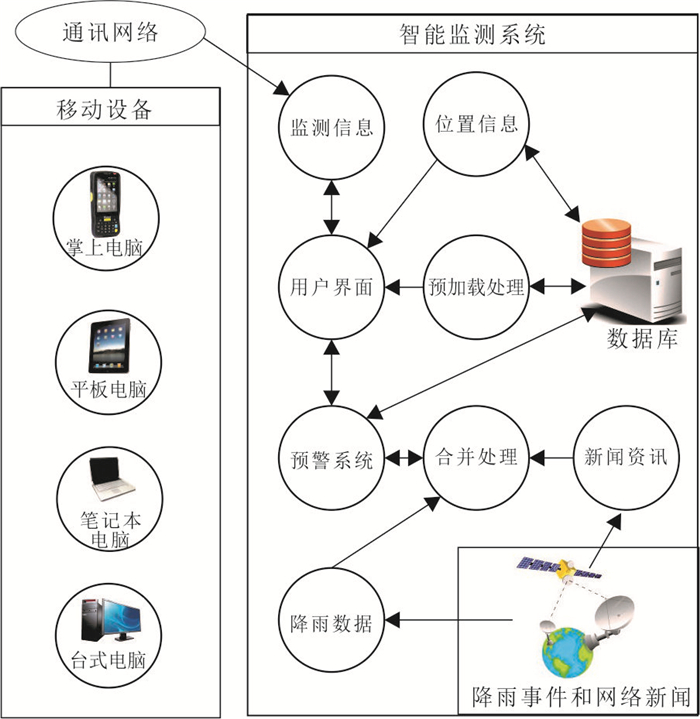State of the Art on Prevention and Control Measures and Impact Model for Debris Flow
-
摘要:
泥石流是一种世界范围内各个历史时期均普遍发生的地质灾害现象,尤其频发于地震多发的山地地区,每年均给人民的生命财产造成重大损失.为了应对这种暴发突然,来势凶猛,破坏力强的泥石流灾害,一系列防治措施应运而生.系统总结泥石流的防治措施.泥石流的防治措施可分为结构化措施和非结构化措施.其中结构化措施包括拦挡坝、拦挡网、导流渠、沉淀池和植被防护措施等,其设计依据可通过泥石流冲击力模型获取.泥石流冲击力模型可分为静力模型、动力模型.非结构化措施即建立泥石流预警和预报系统体系.
Abstract:Debris flow is a worldwide natural hazard that has been common in all historical periods, especially in mountain area with frequent occurrence of earthquakes, causing severe loss of life and property every year. To cope with this sudden, violent, destructive disaster, a series of prevention and control measures have been applied. The measurement of debris flow is summarized systematically in this article. Two kinds of initiatives, namely structured-measures which include check dam, net barrier, drainage channel, sedimentation tank, planting etc. and warning system for unstructured-measures, are used to prevent or reduce the consequence. Static models and hydraulic models are exerted to estimate the impact force of debris flow, furnishing empirical coefficient for structured-measures design.
-
Key words:
- debris flow /
- check dam /
- net barrier /
- drainage channel /
- warning system /
- impact model /
- engineering geolog
-
图 2 泥石流阶梯拦挡坝群(据Cui and Lin, 2013)
Fig. 2. Step⁃check dams for controlling debris flow (modified from Cui and Lin, 2013)
图 3 开口拦挡坝和梳子坝(据Theule et al., 2012)
Fig. 3. Open type check dam and slit dam (modified from Theule et al., 2012)
图 5 导流渠和消能结构
a.据Chen et al.(2015); b.据Chen et al.(2014)
Fig. 5. Drainage channel and energy dissipation cabinet
图 7 泥石流预警系统(修改自Kung et al., 2008)
Fig. 7. Debris flow warning system (modified from Kung et al., 2008)
表 1 k及a与Fr的拟合关系
Table 1. The fitting relationship between empirical coefficient and Froude number
模型 表达式 拟合度(R2) 来源 Fr-k k=9.1Fr 0.77 Scheidl et al.(2013) k=4.86Fr 0.84 Scheidl et al.(2013) k=Fr2 Huang and Zhang(2022) Fr-a a=7.23Fr-0.74 0.60 Scheidl et al.(2013) a=5.44Fr-1.08 0.86 Scheidl et al.(2013) a=5.3Fr-1.3 0.91 Cui et al.(2015) a=3.476Fr-2.389 0.845 Wang et al.(2018) a=4.2Fr-1.2 0.89 Li et al.(2020) -
Abancó, C., Hürlimann, M., Fritschi, B., et al., 2012. Transformation of Ground Vibration Signal for Debris-Flow Monitoring and Detection in Alarm Systems. Sensors, 12(4): 4870-4891. https://doi.org/10.3390/s120404870 Arattano, M., 1999. On the Use of Seismic Detectors as Monitoring and Warning Systems for Debris Flows. Natural Hazards, 20(2-3): 197-213. Arattano, M., Moia, F., 1999. Monitoring the Propagation of a Debris Flow along a Torrent. Hydrological Sciences Journal, 44(5): 811-823. https://doi.org/10.1080/02626669909492275 Armanini, A., 2007. On the Dynamic Impact of Debris Flows. In: Armanini, A., Masanori, M., eds., Recent Developments on Debris Flows. Springer, Berlin, 208-226. https://doi.org/10.1007/bfb0117770 Badoux, A., Graf, C., Rhyner, J., et al., 2009. A Debris-Flow Alarm System for the Alpine Illgraben Catchment: Design and Performance. Natural Hazards, 49(3): 517-539. https://doi.org/10.1007/s11069-008-9303-x Berger, C., McArdell, B.W., Fritschi, B., et al., 2010. A Novel Method for Measuring the Timing of Bed Erosion during Debris Flows and Floods. Water Resources Research, 46(2). https://doi.org/10.1029/2009wr007993 Bisson, M., Favalli, M., Fornaciai, A., et al., 2005. A Rapid Method to Assess Fire-Related Debris Flow Hazard in the Mediterranean Region: An Example from Sicily (Southern Italy). International Journal of Applied Earth Observation and Geoinformation, 7(3): 217-231. https://doi.org/10.1016/j.jag.2005.04.003 Brighenti, R., Segalini, A., Ferrero, A.M., 2013. Debris Flow Hazard Mitigation: A Simplified Analytical Model for the Design of Flexible Barriers. Computers and Geotechnics, 54: 1-15. https://doi.org/10.1016/j.compgeo.2013.05.010 Bugnion, L., McArdell, B.W., Bartelt, P., et al., 2012. Measurements of Hillslope Debris Flow Impact Pressure on Obstacles. Landslides, 9(2): 179-187. https://doi.org/10.1007/s10346-011-0294-4 Chai, B., Tao, Y.Y., Du, J., et al., 2020. Hazard Assessment of Debris Flow Triggered by Outburst of Jialong Glacial Lake in Nyalam County, Tibet. Earth Science, 45(12): 4630-4639(in Chinese with English abstract) Chen, H., Lee, C.F., 2004. Geohazards of Slope Mass Movement and Its Prevention in Hong Kong. Engineering Geology, 76(1-2): 3-25. https://doi.org/10.1016/j.enggeo.2004.06.003 Chen, J.G., Chen, X.Q., Li, Y., et al., 2015. An Experimental Study of Dilute Debris Flow Characteristics in a Drainage Channel with an Energy Dissipation Structure. Engineering Geology, 193: 224-230. https://doi.org/10.1016/j.enggeo.2015.05.004 Chen, J.G., Chen, X.Q., Wang, T., et al., 2014. Types and Causes of Debris Flow Damage to Drainage Channels in the Wenchuan Earthquake Area. Journal of Mountain Science, 11(6): 1406-1419. https://doi.org/10.1007/s11629-014-3045-x Chen, N.S., Li, T.C., Gao, Y.C., 2005. A Great Disastrous Debris Flow on 11 July 2003 in Shuikazi Valley, Danba County, Western Sichuan, China. Landslides, 2(1): 71-74. https://doi.org/10.1007/s10346-004-0041-1 Chen, S.C., Wu, C.Y., 2014. Debris Flow Disaster Prevention and Mitigation of Non-Structural Strategies in Taiwan. Journal of Mountain Science, 11(2): 308-322. https://doi.org/10.1007/s11629-014-2987-3 Chen, X.Q., Cui, P., You, Y., et al., 2015. Engineering Measures for Debris Flow Hazard Mitigation in the Wenchuan Earthquake Area. Engineering Geology, 194: 73-85. doi: 10.1016/j.enggeo.2014.10.002 Collins, T.K., 2008. Debris Flows Caused by Failure of Fill Slopes: Early Detection, Warning, and Loss Prevention. Landslides, 5(1): 107-120. https://doi.org/10.1007/s10346-007-0107-y Cui, P., Lin, Y.M., 2013. Debris-Flow Treatment: The Integration of Botanical and Geotechnical Methods. Journal of Resources and Ecology, 4(2): 97-104. https://doi.org/10.5814/j.issn.1674-764x.2013.02.001 Cui, P., Zeng, C., Lei, Y., 2015. Experimental Analysis on the Impact Force of Viscous Debris Flow. Earth Surface Processes and Landforms, 40(12): 1644-1655. https://doi.org/10.1002/esp.3744 Decaulne, A., 2007. Snow-Avalanche and Debris-Flow Hazards in the Fjords. Natural Hazards, 41(1): 81-98. https://doi.org/10.1007/s11069-006-9025-x DeWolfe, V.G., Santi, P.M., Ey, J., et al., 2008. Effective Mitigation of Debris Flows at Lemon Dam, La Plata County, Colorado. Geomorphology, 96(3-4): 366-377. https://doi.org/10.1016/j.geomorph.2007.04.008 Fei, X.J., Shu, A.P., 2004. Movemet Mechanism and Disaster Control for Debris Flow. Tsinghua University Press, Beijing, 26-32(in Chinese) Han, W.B., Ou, G.Q., 2006. Efficiency of Slit Dam Prevention against Non-Viscous Debris Flow. Wuhan University Journal of Natural Sciences, 11(4): 865-869. https://doi.org/10.1007/bf02830178 Hong, Y., Wang, J.P., Li, D.Q., et al., 2015. Statistical and Probabilistic Analyses of Impact Pressure and Discharge of Debris Flow from 139 Events during 1961 and 2000 at Jiangjia Ravine, China. Engineering Geology, 187: 122-134. https://doi.org/10.1016/j.enggeo.2014.12.011 Hou, R.N., Li, Z., Chen, N.S., et al., 2022. Modeling of Debris Flow Susceptibility Assessment in Tianshan Based on Watershed Unit and Stacking Ensemble Algorithm. Earth Science (in press)(in Chinese with English abstract). https://doi.org/10.3799/dqkx.2022.271 Hu, K.H., Wei, F.Q., Li, Y., 2011. Real-Time Measurement and Preliminary Analysis of Debris-Flow Impact Force at Jiangjia Ravine, China. Earth Surface Processes and Landforms, 36(9): 1268-1278. https://doi.org/10.1002/esp.2155 Huang, H.P., Yang, K.C., Lai, S.W., 2007. Impact Force of Debris Flow on Filter Dam. Momentum, 9(2): 03218. Huang, J., Huang, R.Q., Ju, N.P., et al., 2015.3D WebGIS-Based Platform for Debris Flow Early Warning: A Case Study. Engineering Geology, 197: 57-66. https://doi.org/10.1016/j.enggeo.2015.08.013 Huang, M.L., Hong, J.H., 2010. A Geospatial Service Approach towards the Development of a Debris Flow Early-Warning Systems. Advances in Information Sciences and Service Sciences, 2(2): 107-117. https://doi.org/10.4156/aiss.vol2.issue2.13 Huang, Y., Zhang, B., 2022. Challenges and Perspectives in Designing Engineering Structures against Debris-Flow Disaster. European Journal of Environmental and Civil Engineering, 26(10): 4476-4497. https://doi.org/10.1080/19648189.2020.1854126 Hübl, J., Suda, J., Proske, D., et al., 2009. Debris Flow Impact Estimation. In: Proceedings of the 11th International Symposium on Water Management and Hydraulic Engineering. Ohrid, Macedonia. Ikeya, H., 1989. Debris Flow and Its Countermeasures in Japan. Bulletin of the International Association of Engineering Geology, 40(1): 15-33. https://doi.org/10.1007/bf02590339 Imaizumi, F., Sidle, R.C., Kamei, R., 2008. Effects of Forest Harvesting on the Occurrence of Landslides and Debris Flows in Steep Terrain of Central Japan. Earth Surface Processes and Landforms, 33(6): 827-840. https://doi.org/10.1002/esp.1574 Jaeggi, M.N.R., Pellandini, S., 2007. Torrent Check Dams as a Control Measure for Debris Flows. In: Recent Developments on Debris Flows. Springer, Berlin, Heidelberg, 186-207. https://doi.org/10.1007/bfb0117769 Jakob, M., Hungr, O., 2005. Debris-Flow Hazards and Related Phenomena. Springer, Berlin, Heidelberg. https://doi.org/10.1007/3-540-27129-5_1 Kim, Y., Nakagawa, H., Kawaike, K., et al., 2017. Study on Hydraulic Characteristics of Sabo Dam with a Flap Structure for Debris Flow. International Journal of Sediment Research, 32(3): 452-464. https://doi.org/10.1016/j.ijsrc.2017.05.001 Kung, H.Y., Ku, H.H., Wu, C.I., et al., 2008. Intelligent and Situation-Aware Pervasive System to Support Debris-Flow Disaster Prediction and Alerting in Taiwan. Journal of Network and Computer Applications, 31(1): 1-18. https://doi.org/10.1016/j.jnca.2006.06.008 Lee, S.U., Choi, S.I., Choi, Y.K., 2008. Hazard Prevention Using Multi-Level Debris Flow Barriers. Korean Society for Railway, (2008): 815-829. Lichtenhahn, C., 1973. Berechnung Von Sperren in Beton Und Eisenbeton. Mitteilungen der Forstlichen Bundesanstalt Wien, 102: 91-127. Lin, X.C., Zhang, H.Y., Chen, H.F., et al., 2015. Field Investigation on Severely Damaged Aseismic Buildings in 2014 Ludian Earthquake. Earthquake Engineering and Engineering Vibration, 14(1): 169-176. https://doi.org/10.1007/s11803-015-0014-5 Liu, C.R., Zhao, S.G., 2016. Experimental Study on Mechanism of Large River Blocking by Debris Flow. Journal of Chongqing Jiaotong University (Natural Science), 35(1): 90-95(in Chinese with English abstract). Liu, D.L., Leng, X.P., Wei, F.Q., et al., 2015. Monitoring and Recognition of Debris Flow Infrasonic Signals. Journal of Mountain Science, 12(4): 797-815. https://doi.org/10.1007/s11629-015-3471-4 Liu, J.F., You, Y., Chen, X.C., et al., 2010. Identification of Potential Sites of Debris Flows in the Upper Min River Drainage, Following Environmental Changes Caused by the Wenchuan Earthquake. Journal of Mountain Science, 7(3): 255-263. https://doi.org/10.1007/s11629-010-2017-z Ng, C.W.W., Song, D., Choi, C.E., et al., 2017. Impact Mechanisms of Granular and Viscous Flows on Rigid and Flexible Barriers. Canadian Geotechnical Journal, 54(2): 188-206. https://doi.org/10.1139/cgj-2016-0128 Osanai, N., Mizuno, H., Mizuyama, T., et al., 2010. Design Standard of Control Structures against Debris Flow in Japan. Journal of Disaster Research, 5(3): 307-314. https://doi.org/10.20965/jdr.2010.p0307 Proske, D., Suda, J., Hübl, J., 2011. Debris Flow Impact Estimation for Breakers. Georisk, 5(2): 143-155. https://doi.org/10.1080/17499518.2010.516227 Remaître, A., Malet, J.P., 2011. The Effectiveness of Torrent Check Dams to Control Channel Instability: Example of Debris-Flow Events in Clay Shales. Check Dams, Morphological Adjustements and Erosion Control in Torrential Streams. Nova Science Publishers Inc., New York, 211-237. Scheidl, C., Chiari, M., Kaitna, R., et al., 2013. Analysing Debris-Flow Impact Models, Based on a Small Scale Modelling Approach. Surveys in Geophysics, 34(1): 121-140. https://doi.org/10.1007/s10712-012-9199-6 Scotton, P., Deganutti, A., 1997. Phreatic Line and Dynamic Impact in Laboratory Debris Flow Experiments. In: International Conference on Debris-Flow Hazards Mitigation: Mechanics, Prediction and Assessment. American Society of Civil Engineers, New York, 777-786. Shi, Z.M., Ma, X.L., Peng, M., et al., 2014. Statistical Analysis and Efficient Dam Burst Modelling of Landslide Dams Based on a Large-Scale Database. Chinese Journal of Rock Mechanics and Engineering, 33(9): 1780-1790(in Chinese with English abstract). Shi, Z.M., Xiong, Y.F., Peng, M., et al., 2016. An Efficient Risk Assessment Method for Landslide Dam Breach: Taking the Hongshiyan Landslide Dam Formed by the 2014 Ludian Earthquake as an Example. Journal of Hydraulic Engineering, 47(6): 742-751(in Chinese with English abstract). Shieh, C.L., Ting, C.H., Pan, H.W., 2008. Impulsive Force of Debris Flow on a Curved Dam. International Journal of Sediment Research, 23(2): 149-158. https://doi.org/10.1016/s1001-6279(08)60014-1 Shima, J., Moriyama, H., Kokuryo, H., et al., 2016. Prevention and Mitigation of Debris Flow Hazards by Using Steel Open-Type Sabo Dams. International Journal of Erosion Control Engineering, 9(3): 135-144. https://doi.org/10.13101/ijece.9.135 Suwa, H., Okano, K., Kanno, T., 2009. Behavior of Debris Flows Monitored on Test Slopes of Kamikamihorizawa Creek, Mount Yakedake, Japan. International Journal of Erosion Control Engineering, 2(2): 33-45. https://doi.org/10.13101/ijece.2.33 Takahashi, T., 2007. Debris Flow: Mechanics, Prediction and Countermeasures. Taylor & Francis, London. Tang, B.X., Zhou, B.F., Wu, J.S., 2000. Debris Flow of China. The Commercial Press, Beijing (in Chinese) Tang, C., Rengers, N., van Asch, T.W.J., et al., 2011a. Triggering Conditions and Depositional Characteristics of a Disastrous Debris Flow Event in Zhouqu City, Gansu Province, Northwestern China. Natural Hazards and Earth System Sciences, 11(11): 2903-2912. https://doi.org/10.5194/nhess-11-2903-2011 Tang, C., Zhu, J., Ding, J., et al., 2011b. Catastrophic Debris Flows Triggered by a 14 August 2010 Rainfall at the Epicenter of the Wenchuan Earthquake. Landslides, 8(4): 485-497. https://doi.org/10.1007/s10346-011-0269-5 Tecca, P.R., Armento, C., Genevois, R., 2006. Debris Flow Hazard and Mitigation Works in Fiames Slope (Dolomites, Italy). WIT Transactions on Ecology and the Environment. WIT Press, UK. https://doi.org/10.2495/deb060021 Theule, J.I., Liébault, F., Loye, A., et al., 2012. Sediment Budget Monitoring of Debris-Flow and Bedload Transport in the Manival Torrent, SE France. Natural Hazards and Earth System Sciences, 12(3): 731-749. https://doi.org/10.5194/nhess-12-731-2012 Wang, D.P., Chen, Z., He, S.M., et al., 2018. Measuring and Estimating the Impact Pressure of Debris Flows on Bridge Piers Based on Large-Scale Laboratory Experiments. Landslides, 15(7): 1331-1345. https://doi.org/10.1007/s10346-018-0944-x Wang, G.L., 2013. Lessons Learned from Protective Measures Associated with the 2010 Zhouqu Debris Flow Disaster in China. Natural Hazards, 69(3): 1835-1847. https://doi.org/10.1007/s11069-013-0772-1 Wang, Y.Y., Zhan, Q.D., Yan, B.Y., 2014. Debris-Flow Rheology and Movement. Hunan Science & Technology Press, Changsha, 2-7(in Chinese). Watanabe, M., I., 1981. Investigation and Analysis of Volcanic Mud Flows on Mount Sakurajima, Japan. In: International Association on Hydrology, ed., Erosion Sediment Transport Measurement. Science Publication, Florence, 245-256. Wendeler, C., Volkwein, A., Denk, M., et al., 2007. Field Measurements Used for Numerical Modelling of Flexible Debris Flow Barriers. 4th International Conference on Debris-Flow Hazards Mitigation-Mechanics, Prediction, and Assessment. Chengdu, China, 681-687 https://doi.org/20.500.11850/57642 Yang, Q.G., Wang, X.R., Ma, W.F., et al., 2021. Design of Geo-Hazard Early Warning and Forecast System Based on Micro-Service Architecture. Earth Science, 46 (4): 1505-1517(in Chinese with English abstract). Yin, H., Huang, C.J., Chen, C.Y., et al., 2011. The Present Development of Debris Flow Monitoring Technology in Taiwan: A Case Study Presentation. Italian Journal of Engineering Geology and Environment. https://doi.org/10.4408/ijege.2011-03.b-068 You, Y., Pan, H.L., Liu, J.F., et al., 2011. The Optimal Cross-Section Design of the "Trapezoid-V" Shaped Drainage Canal of Viscous Debris Flow. Journal of Mountain Science, 8(1): 103-107. https://doi.org/10.1007/s11629-011-1023-0 Yu, B., Ma, Y., Wu, Y.F., 2010a. Investigation of Severe Debris Flow Hazards in Wenjia Gully of Sichuan Province after the Wenchuan Earthquake. Journal of Engineering Geology, 18(6): 827-836(in Chinese with English abstract). Yu, B., Yang, Y.H., Su, Y.C., et al., 2010b. Research on the Giant Debris Flow Hazards in Zhouqu County, Gansu Province on August 7, 2010. Journal of Engineering Geology, 18(4): 437-444(in Chinese with English abstract). Yu, G.A., Huang, H.Q., Wang, Z.Y., et al., 2012. Rehabilitation of a Debris-Flow Prone Mountain Stream in Southwestern China: Strategies, Effects and Implications. Journal of Hydrology, 414-415: 231-243. https://doi.org/10.1016/j.jhydrol.2011.10.036 Zanuttigh, B., Lamberti, A., 2006. Experimental Analysis of the Impact of Dry Avalanches on Structures and Implication for Debris Flows. Journal of Hydraulic Research, 44(4): 522-534. https://doi.org/10.1080/00221686.2006.9521703 Zhang, B., Huang, Y., Liu, J., 2021. Micro-Mechanism and Efficiency of Baffle Structure in Deceleration of Granular Flows. Acta Geotechnica, 16(11): 3667-3688. https://doi.org/10.1007/s11440-021-01290-x Zhang, S.C., 1993. A Comprehensive Approach to the Observation and Prevention of Debris Flows in China. Natural Hazards, 7(1): 1-23. https://doi.org/10.1007/bf00595676 Zhang, W., Li, H.Z., Chen, J.P., et al., 2011. Comprehensive Hazard Assessment and Protection of Debris Flows along Jinsha River Close to the Wudongde Dam Site in China. Natural Hazards, 58(1): 459-477. https://doi.org/10.1007/s11069-010-9680-9 Zheng, H.C., Shi, Z.M., de Haas, T., et al., 2022. Characteristics of the Impact Pressure of Debris Flows. Journal of Geophysical Research: Earth Surface, 127(3): e2021JF006488. https://doi.org/10.1029/2021jf006488 Zhou, G.D., Cui, P., Tang, J.B., et al., 2015. Experimental Study on the Triggering Mechanisms and Kinematic Properties of Large Debris Flows in Wenjia Gully. Engineering Geology, 194: 52-61. https://doi.org/10.1016/j.enggeo.2014.10.021 Zhuang, J.Q., Cui, P., Hu, K.H., et al., 2010. Characteristics of Earthquake-Triggered Landslides and Post-Earthquake Debris Flows in Beichuan County. Journal of Mountain Science, 7(3): 246-254. https://doi.org/10.1007/s11629-010-2016-0 Zhuang, J.Q., Cui, P., Peng, J.B., et al., 2013. Initiation Process of Debris Flows on Different Slopes Due to Surface Flow and Trigger-Specific Strategies for Mitigating Post-Earthquake in Old Beichuan County, China. Environmental Earth Sciences, 68(5): 1391-1403. https://doi.org/10.1007/s12665-012-1837-2 柴波, 陶阳阳, 杜娟, 等, 2020. 西藏聂拉木县嘉龙湖冰湖溃决型泥石流危险性评价. 地球科学, 45(12): 4630-4639. doi: 10.3799/dqkx.2020.294 费祥俊, 舒安平, 2004. 泥石流运动机理与灾害防治. 北京: 清华大学出版社, 26-32. 侯儒宁, 李志, 陈宁生, 等, 2022. 基于流域单元和堆叠集成模型的天山地区泥石流易发性评估建模. 地球科学(待刊). 刘翠容, 赵世刚, 2016. 泥石流阻塞大河机理试验研究. 重庆交通大学学报(自然科学版), 35(1): 90-95. https://www.cnki.com.cn/Article/CJFDTOTAL-CQJT201601018.htm 石振明, 马小龙, 彭铭, 等, 2014. 基于大型数据库的堰塞坝特征统计分析与溃决参数快速评估模型. 岩石力学与工程学报, 33(9): 1780-1790. https://www.cnki.com.cn/Article/CJFDTOTAL-YSLX201409008.htm 石振明, 熊永峰, 彭铭, 等, 2016. 堰塞湖溃坝快速定量风险评估方法: 以2014年鲁甸地震形成的红石岩堰塞湖为例. 水利学报, 47(6): 742-751. https://www.cnki.com.cn/Article/CJFDTOTAL-SLXB201606004.htm 唐邦兴, 周必凡, 吴积善, 2000. 中国泥石流. 北京: 商务印书馆. 王裕宜, 詹钱登, 严璧玉, 2014. 泥石流体的流变特性与运移特征. 长沙: 湖南科学技术出版社, 2-7. 杨强根, 王晓蕊, 马维峰, 等, 2021. 基于微服务架构的地质灾害监测预警预报系统设计. 地球科学, 46(4): 1505-1517. doi: 10.3799/dqkx.2020.128 余斌, 马煜, 吴雨夫, 2010a. 汶川地震后四川省绵竹市清平乡文家沟泥石流灾害调查研究. 工程地质学报, 18(6): 827-836. https://www.cnki.com.cn/Article/CJFDTOTAL-GCDZ201006003.htm 余斌, 杨永红, 苏永超, 等, 2010b. 甘肃省舟曲8·7特大泥石流调查研究. 工程地质学报, 18(4): 437-444. https://www.cnki.com.cn/Article/CJFDTOTAL-GCDZ201004002.htm -










 下载:
下载:







